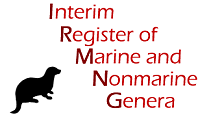
| Intro | | Search taxa | | Taxon tree | | Search literature | | Taxon match | | Homonyms | | Statistics | | Webservice | | Manual | | FAQ | | LifeWatch | | Download | | Log in |
Interim Register of Marine and Nonmarine Genera (IRMNG)1,313,920 accepted species 1,782,609 species names including synonyms31,105 accepted fossil-only species 264,112 accepted genera 122,429 synonymized genera (unaccepted) 21,544 genera of other (nomenclatural) status 118,607 uncertain genera (status not assessed yet) 2,340,722 taxon names (infraspecies to kingdoms) (188,379) 168 sources with full text Last update: 2 hours ago IRMNGThe Interim Register of Marine and Nonmarine Genera is a provisional (or ‘interim’) compilation of genus names – including species names in many cases – and covers both living and extinct biota into a single system to support taxonomic and other queries dealing with e.g. homonyms, authorities, parent-child relationships, spelling variations and distinctions between marine and non-marine or fossil and recent taxa.
Taxonomic names in IRMNG are assigned flags to distinguish between marine vs. non-marine, and extant vs. fossil status;
they are also arranged into a simple management hierarchy for navigation purposes, compilation of statistics per taxonomic group and more.
Fuzzy matching is also supported (using "Taxamatch") so that a misspelled name can in most instances be reconciled to a correctly spelled name
at genus or species rank, where this is held.
HistoryIRMNG commenced in 2006 following an analysis of needs in respect of taxonomic names management for the Ocean Biodiversity Information System (OBIS). The main objectives were to fill the gaps and produce a hierarchical classification of all life, extant + fossil, to at least genus level and provide a tool to distinguish marine from non-marine taxa.It was designed as a contribution to the International OBIS system from OBIS Australia, which is hosted at CSIRO Marine and Atmospheric Research (CMAR) in Australia, and also used as taxonomic information system by other initiatives. CMAR contributed in kind to IRMNG development and ongoing hosting as part of its commitment to OBIS AU, and small amounts of OBIS, GBIF and Atlas of Living Australia funds have contributed to aspects of its population. Late 2013, the database manager and curator of IRMNG – Tony Rees, who was awarded the prestigious GBIF Ebbe Nielsen Prize for 2014- started to look for a new host institute for his database. The Flanders Marine Institute (VLIZ) made an offer – including hosting, adding & distributing content and the possible development of new features for IRMNG – which has been accepted by Tony and the former host institute CSIRO in Australia. During 2014 and 2015, the data transfer and integration from CSIRO to VLIZ was prepared, leading to the new launch early 2016. Sources & ContributorsInitial sources utilised for creation of IRMNG include the Nomenclator Zoologicus compilation of zoological genus names (1758-2004), the Index Nominum Genericorum compilation of botanical names (sensu lato), the Catalogue of Life compilation of species names (2006 version, to be updated in due course) and a range of others including both databases and print works.Frequently the required information on a given name is required to be assembled from multiple sources, for example Nomenclator Zoologicus gives names but not families or taxonomic status, Index Nominum Genericorum gives names and families (which may have subsequently changed) but not taxonomic status, and so on. Contributors to this project include:
VisionThe transfer of hosting institution for IRMNG will not cease the existing database nor stop the development and updates of the register in the future. Close collaboration with Tony Rees will remain.The Flanders Marine Institute (VLIZ) will provide ongoing hosting of the IRMNG data content, using the same infrastructure that is currently provided to host the World Register of Marine Species (WoRMS) and with the technical support already in place. VLIZ will also support the web interfaces for the external users so they can easily query existing and future IRMNG content and continue the delivery of IRMNG data dumps for the benefit of significant-scale IRMNG users such as e.g. GBIF, EoL, ALA, OBIS and many more. In time – and as resources permit – VLIZ will develop additional services over both IRMNG and WoRMS to serve the users’ needs. Also content-wise, VLIZ will contribute to IRMNG by committing to help build an editor network – similar to the WoRMS editor network - who can help to keep the IRMNG information up-to-date and to help fill in the already identified gaps within the database.
The transfer and hosting of IRMNG is supported by LifeWatch Belgium, part of the E-Science European LifeWatch Infrastructure for Biodiversity and Ecosystem Research.
LifeWatch is a distributed virtual laboratory which is used for different aspects of biodiversity research. The LifeWatch Species Information Backbone aims at bringing
together taxonomic and species-related data and at filling the gaps in our knowledge.
More information on IRMNG?Publications:
Contactinfo@irmng.orgTerms of useIRMNG content at genus level and above is open-access under the terms of the Creative Commons Attribution License (CC-BY). This License permits unrestricted use, provided it is cited as below.IRMNG records below the level of genus may be subject to other restrictions on redistribution according to the data sources from which they originate (e.g. Catalogue of Life 2006 version or other) and permission for their re-use may require to be sought from the original data sources used for IRMNG compilation. CitationRees, T. (compiler) (2025). The Interim Register of Marine and Nonmarine Genera. Available from https://www.irmng.org at VLIZ. Accessed 2025-12-11 |